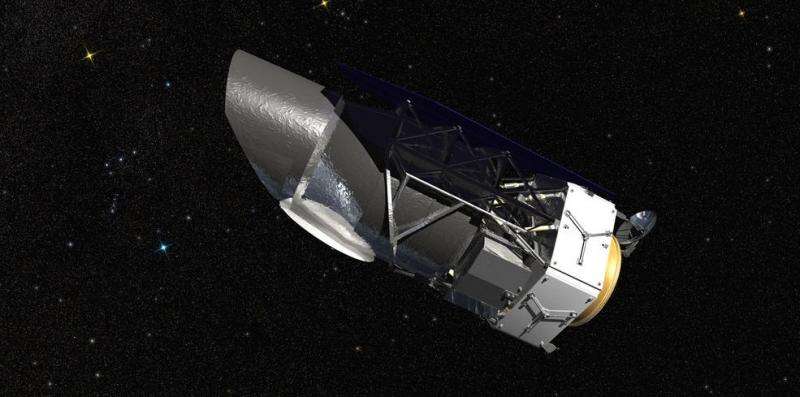NASA's WFIRST spacecraft offers a huge step forward in our understanding of dark matter

NASA's Wide Field Infrared Survey Telescope (WFIRST) could be a space observatory of the future, destined for great discoveries in the field of astrophysics. With a view about 100 times larger than that of the venerable Hubble Space Telescope, WFIRST is expected to yield crucial results about the elusive dark matter and dark energy.
Dark matter and dark energy have perplexed astronomers for years. WFIRST is currently being designed to address the most baffling questions about these mysterious phenomena, which together account for about 95 percent of the mass-energy of the universe.
"WFIRST will survey large areas of the sky measuring the effects of dark matter on the distribution of galaxies in the universe. It will also observe distant Type Ia supernovae to use them as tracers of dark matter and dark energy. It will provide a huge step forward in our understanding of dark matter and dark energy," Brooke Hsu of NASA's Goddard Space Flight Center in Greenbelt, Md. told Astrowatch.net.
WFIRST is managed at Goddard, with participation by the Jet Propulsion Laboratory (JPL) in Pasadena, California, the Space Telescope Science Institute in Baltimore, the Infrared Processing and Analysis Center, also in Pasadena, and a science team comprised of members from U.S. research institutions across the country.
The spacecraft is currently in Phase A of preparations. The purpose of this phase is to develop the mission requirements and architecture necessary to meet the programmatic requirements and constraints on the project and to develop the plans for the Preliminary Design Phase. The preparations are on track for a mid-2020 launch. After liftoff, the telescope will travel to a gravitational balance point known as Earth-Sun L2, located about one million miles from Earth in a direction directly opposite the sun.
Operating at L2, WFIRST will use several techniques to study dark matter and dark energy. The High Latitude Spectroscopic Survey will measure accurate distances and positions of a very large number of galaxies. It will measure the growth of the large structure of the universe, testing Einstein's General Relativity theory.
"It will perform large surveys of galaxies and galaxy clusters to see the effects of dark matter and energy on their shapes and distributions in the universe. All told, more than a billion galaxies will be observed by WFIRST," Hsu revealed.
The spacecraft will conduct the Type Ia Supernovae (SNe) Survey which will use type Ia SNe as "standard candles" to measure absolute distances. Calculating the distance to and redshift of the SNe provides another means of measuring the evolution of dark energy over time, providing a cross-check with the high latitude surveys.
"It will observe Type Ia supernovae to determine their distance and properties. More than 2,000 supernovae will be observed," Hsu said.
WFIRST will also carry out the High Latitude Imaging Survey that will measure the shapes and distances of a very large number of galaxies and galaxy clusters. This survey is expected to determine both the evolution of dark energy over time as well as provide another independent measurement of the growth of large structure of the universe.
But WFIRST is not only about astrophysics. The infrared telescope will also have a chance to prove its usefulness as an exoplanet hunter. It will use microlensing techniques to expand our catalog of known extrasolar planets and will directly characterize these alien worlds using coronagraphy.
"WFIRST will study exoplanets with two very different techniques: microlensing and coronagraph. The mission will stare at the a dense star region toward the direction of the center of our Milky Way galaxy to observe microlensing events. These brightenings are caused when two stars exactly align and also provide a tally of the exoplanets around the stars. Over 2,000 exoplanets will be detected this way," Hsu noted.
To fulfill its scientific goals, WFIRST will be equipped in a 2.4-meter telescope hosting two instruments: the Wide-Field Instrument (WFI) and a high contrast coronagraph. WFI will provide the wide-field imaging and slitless spectroscopic capabilities required to perform the dark energy, exoplanet microlensing, and near-infrared (NIR) surveys while the coronagraph instrument is being designed for the exoplanet high contrast imaging and spectroscopic science.
"The Wide Field Instrument provides wide-field imaging and spectroscopy in support of the dark energy and microlensing surveys and integral field spectroscopy in support of the supernova survey," Hsu said.
The coronagraph will be able to detect more than 50 exoplanets and observe their properties.
"It will be a huge leap forward compared to current instruments. Most exciting will be spectral observations of the light from the planets to see what the properties are of the atmospheres and possibly surfaces. Searches will be made for signatures of life on the planets," Hsu said.
By operating WFIRST, NASA hopes to make major discoveries in the areas of dark matter and energy, exoplanets and general astrophysics. The agency expects to learn the nature of dark matter and energy to determine what they are.
"We will survey the sky to find the most exotic and interesting galaxies, black holes, and stars. We will take a census of exoplonets that are beyond on astronomical unit from their stars, a region that Kepler is not able to survey. We will make the first sensitive direct observation of nearby exoplanets and find what their nature is and if there are signatures of life," Hsu concluded.
Provided by Astrowatch.net




















